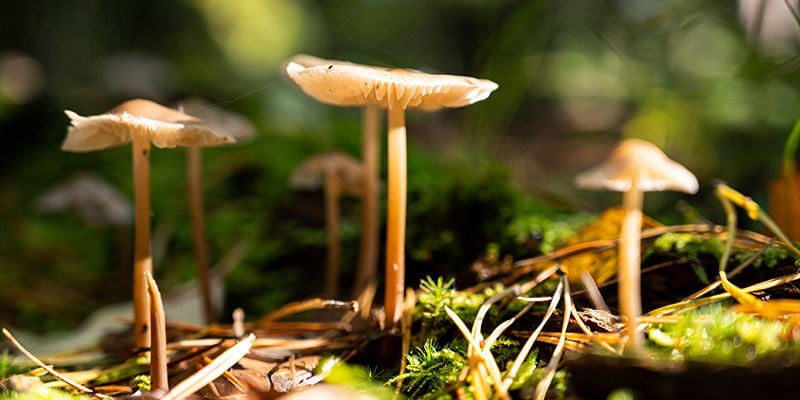
What Is Paul Stamets' Microdosing Stack?
What if there was a substance that could nourish the brain, fight off neurodegeneration, and increase learning ability? According to one leading researcher, there just might be! The research is early, but results look promising. Let's explore the theory and applications of Paul Stamets' protocol.
Researchers and entrepreneurs are racing to discover molecules that improve brain health and offer an edge in mental performance. Many of these chemicals are being synthesised in laboratories, whereas others exist in nature. This article will investigate the so-called Paul Stamets' "protocol" (also referred to as "Niacin Lion's Mane Psilocybin protocol", "microdosing stack", "neurogenesis stack", or just "stack"), a nootropic formula proposed to improve cognitive function and guard against neurodegeneration.
Who is Paul Stamets, and what is his theory?

Paul Stamets is an autodidact mycologist, researcher, and author. He’s a prominent individual in the mushroom community who gained renown after penning the grow bibles "The Mushroom Cultivator" and "Growing Gourmet Mushrooms". These manuals detail every element of mushroom cultivation from substrate preparation to incubation to sterile techniques.
Stamets broke into the mainstream after delivering a TED talk entitled "6 Ways Mushrooms Can Save The World". He detailed the nature of fungi, how their networks resemble the internet, and how they were the first life forms to take to land. Discussing some of his revolutionary discoveries, Stamets explained how cordyceps mushrooms could be used as an alternative to pesticides, whereas other species can absorb oil. This barrage of paradigm-shifting information introduced many people to mycology for the first time, and it promoted Stamets as a figurehead in the field.
This 17-minute address wasn’t enough time for Stamets to present all of his fungal epiphanies. He’s presented many other ideas across numerous speaking events and podcasts. Included in this is Paul Stamets’ protocol.
The protocol revolves around a nootropic vitamin complex comprised of niacin, lion’s mane mushroom, and the crucial prodrug in magic mushrooms, psilocybin. Stamets refers to this as the stacking formula for epigenetic neurogenesis.
The mycologist was prompted to develop the blend due to the striking rise of neurodegenerative conditions such as Alzheimer's disease. He theorises that the combination of chemicals could be useful in the treatment of PTSD and the regeneration of visual and auditory neurons. In healthy individuals, the stack could potentially be used to enhance creativity and expand cognitive function.
The stack — formulas and quantities

So, you're familiar with the 3 main ingredients of the Stamets Stack. But what concentration of each ingredient works best according to Stamets? Well, his most popular (and most cited) stack formula goes as follows:
-
1 microdose of psilocybin mushrooms. A microdose of Psilocybe cubensis (the most common and most studied species of magic mushroom) amounts to 0.1–0.2g of dried mushrooms or 1–2g of fresh mushrooms. According to Stamets, this is a great starting point, though some experienced mushroom users prefer to take a "low dose" (0.5–1g of dried cubensis mushrooms, or 5–10g of fresh mushrooms). Note, however, that these heightened doses can produce more notable psychedelic effects.
-
5–20g of fresh lion's mane mushroom. Note that sourcing fresh lion's mane is challenging, so you can use between 50–200mg of powdered extract or an equivalent amount of liquid lion's mane extract. While lion's mane isn't toxic, it may affect blood clotting (in predisposed people) or lower blood glucose levels.
-
101–200mg of niacin. Note that taking niacin in supplement form may produce a temporary tingling/itching sensation or skin flushing. Taking large doses of niacin (2000mg or more per day) can cause more severe side effects.
NOTE: The above Stamets Stack formula is for individuals weighing roughly 70kg. If you're sensitive to psychedelics or have never taken them before, you may want to use lower concentrations. On the other hand, if you're experienced with psychedelics or weigh over 70kg, you may want to use doses toward the higher end of the ranges described above.
Keep in mind that taking psychedelics isn't an exact science, and different people will likely have different responses to the Stamets Stack. In general, we always recommend starting at a low dose and working your way up to find the dose that works best for you. Also, remember that the Stamets Stack is designed to be taken for 4–5 consecutive days, followed by a 2 or 3-day break.
Psilocybin and the growth of new brain cells

Psilocybin has demonstrated interesting results in early research. A 2018 study found psychedelics to promote structural and functional neural plasticity. These findings suggest entheogens like magic mushrooms to have potential in the realm of mental maladies such as treatment-resistant depression.
Additional animal research investigated the effects of psilocybin on neurogenesis. A biphasic dose-response was observed: low doses of the molecule increased hippocampal neurogenesis, whereas higher doses decreased the formation of new neurons. A testament to microdosing.
It was also found that psilocybin leads to the extinction of conditioned fear response in rodents. Researchers concluded that the molecule should be explored as a potential treatment for PTSD and related conditions.
Lion’s Mane — a fungal brain tonic

Lion’s mane, Hericium erinaceus, is a gourmet medicinal mushroom native to North America, Europe, and Asia. It can be foraged from beech trees and is a popular variety to cultivate at home. It’s known for its meaty texture and lobster-like flavour.
This fungus is more than a culinary delight. It stimulates the release of nerve growth factor (NGF), a neurotrophic that promotes the growth of neurons in nerve cells. Lion’s mane extract contains classes of molecules known as hericenones and erinacines. These chemicals encourage the synthesis of NGF. When administered alongside NGF, lion’s mane extract was able to promote neurite outgrowth, a process that occurs during nerve regeneration.
Niacin — a vital vitamin

Niacin, or vitamin B3, is a crucial nutrient required for many physiological processes. The water-soluble vitamin plays a role in cell signalling, DNA repair, and metabolism. Deficiency can manifest as depression, headache, memory loss, and confusion.
Niacin is required by the brain. The nutrient helps to form key enzymes responsible for normal cognitive function. Dietary treatment with nicotinamide riboside—a certain form of vitamin B3—appears to be beneficial for Alzheimer’s disease. Research shows that the nutrient benefits synaptic plasticity and prevents plaque formation.
High doses of niacin cause a relatively harmless yet unusual side effect: the niacin flush. The flush manifests as redness on the skin soon followed by sensations of warmth, itching, and burning. This is caused by dilation of peripheral blood vessels. As they open, more blood is allowed to rush through.
Some users find this unpleasant. A non-flush formula has been developed to help people avoid this side effect. However, it’s precisely this mechanism that makes niacin a valuable addition to Paul Stamets' protocol.
The mycologist hypothesises that the niacin flush will drive hericenones, erinacines, and psilocybin to nerve cells in the peripheral nervous system. Here, they could work on different receptor sites and potentially stave off neurological conditions.
The progeny of the “stoned ape” theory

The idea that psilocybin enhances cognitive function isn’t new. The late ethnobotanist and author Terence McKenna proposed the “stoned ape” theory. He believed psilocybin mushrooms catalysed a rapid expansion of the human brain, an event that gave rise to self-awareness and abstract thought.
McKenna presented the theory in his book Food of the Gods. He questioned the conventional roots of human cognition, citing a lack of explanation as to the development of language and music, not to mention the sudden doubling in size of the human brain some 800,000–200,000 years ago.
McKenna stated that our hominid ancestors would have stumbled across psychedelic fungi as the climate started to shift. An increase in temperature led to a recession in the tropical African forests, leaving savannah in their wake. This drove our ancestors out of the canopy and onto the plains.
In search of new sources of food, these primordial primates started investigating the grassland. Eventually, they would discover psilocybin mushrooms sprouting forth from the manure of large herbivores.
McKenna states that this new dietary source of psilocybin would have boosted visual acuity, providing a stark advantage during hunting. He believes mushroom consumption would have increased libido, resulting in more offspring for those who indulged. Higher doses would eventually give rise to religion, philosophy, science, and complex language.
Ultimately, the stoned ape theory suggests that access to psilocybin mushrooms was a critical evolutionary advantage that accelerated the evolution of the human brain.
Paul Stamets' protocol draws some inspiration from this idea, as well as the more recent scientific discoveries mentioned above. Stamets refers to McKenna's brainchild as the stoned ape “hypothesis” due to lack of evidence.
Stamets agrees that ingestion of these fungi may have had a profound impact on human consciousness. He states our hunter-gatherer ancestors would have been scanning the ground for dung whilst tracking prey—precisely the hotbed from which many psychoactive fungi grow.
During an episode of “The Joe Rogan Experience”, Stamets mentioned that psilocybin would have acted in place of serotonin, activated neurogenesis, given rise to new brain cells, and formed new pathways of knowledge. He also discussed psilocybin's effect on the fear response and how newfound courage would have helped our ancestors survive.
If psilocybin was responsible for this leap in cognition, it would have been a slow and sustained process. Millions of encounters between hominids and hallucinogenic fungi—over millions of years—would have given rise to the epigenetic neurogenesis at the root of this advancement. Stamets' protocol is a progeny of the stoned ape theory, yet more grounded in research and practicality.
Science has shown that psilocybin presents an interesting means of inducing neurogenesis, but to what degree did this affect our evolutionary trajectory? This enquiry remains unanswered. But it begs the question: if psilocybin was responsible for the modern mind, do we still require it for optimal function? Regardless of the answer, Paul Stamets' protocol holds promise as a means of boosting brain function and fending off neurodegeneration.
Before getting too excited, it’s important to ingest a healthy dose of scepticism here. Whilst the early research looks promising, it’s still early research. Neurogenesis stimulated by psilocybin has been demonstrated in animals, but not human subjects. Hopefully, as research advances, we’ll see more concrete evidence emerge.
What are the possible long-term effects of the protocol?

A lack of clinical trials means one can only provide an estimation. Stamets is on-record stating how his formula will benefit the ailing, the healthy, the individual, and society. He claims it could increase cognition in students, coders, researchers, and academics. Altered visual, auditory, and spatial perception could offer athletes a performance advantage. Moreover, there is said to be promise of relieving those challenged with neurotoxins, diseases of the nervous system, and anxiety.
This projection appears bombastic. It’s a laundry list only a magic bullet could leave squeaky clean. But it’s hard to deny the impact that psilocybin alone could have on society. In a patent application for the formula, Stamets rolls out a complete list of claims. This includes efficacy in regards to:
- Improving memory and cognition
- Improving motor skills and coordination
- Improving the ability to solve complex computer challenges
- Improving hearing
- Improving vision
- Improving sensory function
- Improving learning
- Promoting neurogenesis
How long does it take to feel the benefits?
Again, we are shining a spotlight into the shadowy realm of anecdotes here. No scientific publication has explored these answers. Reddit users and forum dwellers are leading the charge. This is an exciting peek into possible effects, but the lack of methodology makes for unreliable data. Some anecdotes state near-instant changes. One blogger reports an immediate improvement in flexibility, coordination, and athletic performance. Stamets explains it might take up to a year to yield noticeable results, which appears much more reasonable.
- (n.d.). US Patent Application for Compositions and methods for enhancing neuroregeneration and cognition by combining mushroom extracts containing active ingredients psilocin or psilocybin with erinacines or hericenones enhanced with niacin Patent Application (Application #20180021326 issued January 25, 2018) - Justia Patents Search - https://patents.justia.com
- Calvin Ly, Alexandra C. Greb, Lindsay P. Cameron, Jonathan M. Wong, Eden V. Barragan, Paige C. Wilson, Kyle F. Burbach, Sina Soltanzadeh Zarandi, Alexander Sood, Michael R. Paddy, Whitney C. Duim, Megan Y. Dennis, A. Kimberley McAllister, & Kassandra M. Ori-. (2018/06/06). Psychedelics Promote Structural And Functional Neural Plasticity - https://www.ncbi.nlm.nih.gov
- Catlow BJ, Song S, Paredes DA, Kirstein CL, & Sanchez-Ramos J. (2013 Aug). Effects of psilocybin on hippocampal neurogenesis and extinction of trace fear conditioning - https://www.ncbi.nlm.nih.gov
- M C Morris, D A Evans, J L Bienias, P A Scherr, C C Tangney, L E Hebert, D A Bennett, R S Wilson, & N Aggarwal. (2004/08/01). Dietary niacin and the risk of incident Alzheimer’s disease and of cognitive decline - https://jnnp.bmj.com
-
 5 min
5 October 2023
Microdosing CBD: Helpful Practice Or Passing Trend?
Is it possible to microdose CBD? Maybe, but even if it is, it's hard to say what a microdose would actually be, and what effects it might have. Read on as we separate the facts from the fluff...
5 min
5 October 2023
Microdosing CBD: Helpful Practice Or Passing Trend?
Is it possible to microdose CBD? Maybe, but even if it is, it's hard to say what a microdose would actually be, and what effects it might have. Read on as we separate the facts from the fluff...
-
 4 min
21 June 2021
The Stoned Ape Theory Of Human Evolution
As modern science unfurls some of the mysteries surrounding the effects of magic mushrooms on the brain, we return to an older theory. Put forth by Terence McKenna in the 90s, the stoned ape theory...
4 min
21 June 2021
The Stoned Ape Theory Of Human Evolution
As modern science unfurls some of the mysteries surrounding the effects of magic mushrooms on the brain, we return to an older theory. Put forth by Terence McKenna in the 90s, the stoned ape theory...
-
 3 min
17 August 2020
5 Surprising Benefits of Magic Mushrooms
There are so many factors to consider when taking magic mushrooms, and it can be daunting overall. However, there are many benefits to taking this psilocybin-packed hallucinogen. Continue reading...
3 min
17 August 2020
5 Surprising Benefits of Magic Mushrooms
There are so many factors to consider when taking magic mushrooms, and it can be daunting overall. However, there are many benefits to taking this psilocybin-packed hallucinogen. Continue reading...
-
 4 min
8 August 2017
Top 10 Surprising Facts About Psychedelics
Brushing up on history and reading about new developments may be a bit boresome, but, as one might expect, there are quite a few astonishing anecdotes and crazy stories coming from the world of...
4 min
8 August 2017
Top 10 Surprising Facts About Psychedelics
Brushing up on history and reading about new developments may be a bit boresome, but, as one might expect, there are quite a few astonishing anecdotes and crazy stories coming from the world of...













 United States
United States










